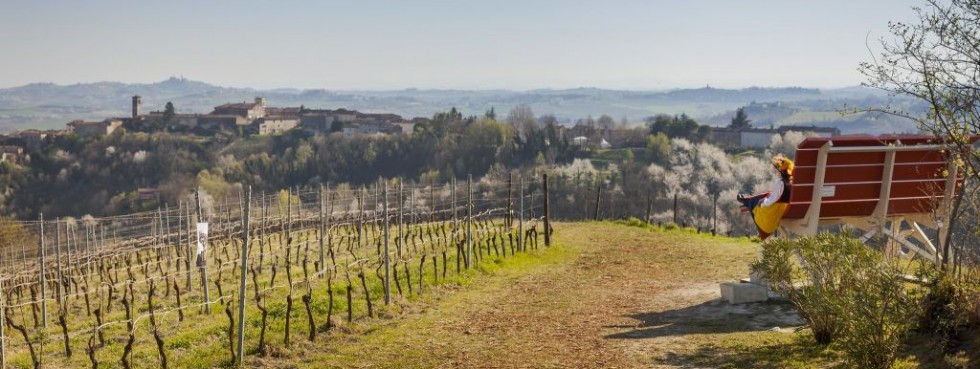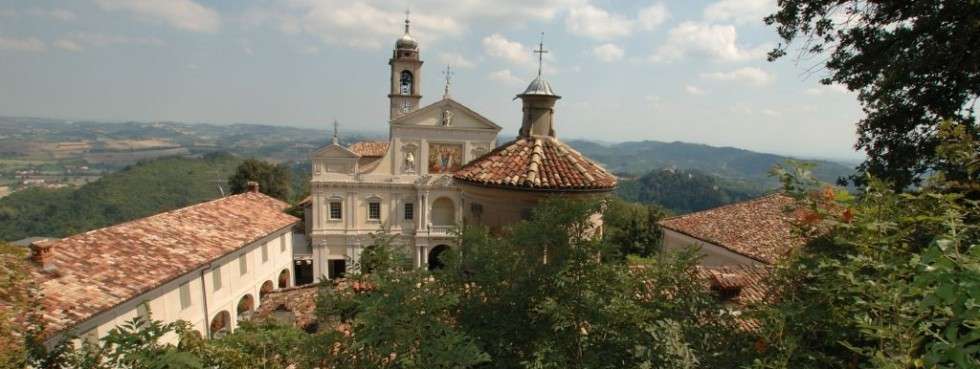The Monferrato area in and around

Casale Monferrato in and around: vineyard landscapes, Unesco sites, castles and the plain of the Po river
CASALE MONFERRATO: ONE OF THE MOST INTERESTING ART CITIES IN PIEDMONT
The main town of the area is Casale Monferrato, not far from Turin, Milan and Genoa (about one hour by car). Your visit of the area should start from here, the ancient capital of the Monferrato Marquisate and one of the most interesting art cities in Piedmont. Casale Monferrato stands on the right bank of the Po river, a short distance away from the Monferrato’s countryside. The historic center, enclosed within the polygonal perimeter of the disappeared defensive walls, predominantly presents 18th century aspects, while retaining important Medieval, Romanesque and Gothic monuments. A fortified military town of primary importance, that was for several centuries at the centre of the troubled political events that marked the history of the Monferrato Marquisate history, of which Casale was the capital in the 15th century. Walking in the historic center, that presents features from its ancient past, is the best way to experience its many treasures: interesting museums and sights, elegant buildings, majestic churches and porticoes.
In the middle of the main square (parking area) is the imposing, recently restored Monferrato Castle dating from mid-14th century. In the town center: the Cathedral with its splendid Narthex and Romanesque crucifix, as well as an extremely modern Centenary Baptistery, the work of the sculptor Lodigiani; the church of San Domenico and its adjoining cloister, with valuable works by Guala; the church of Santa Caterina of the Domenican nubs, built by Giacomo Zanetti following a project by Giovanni Battista Scapitta (1653-1715), consecrated in 1726; the baroque Synagogue and Jewish Museum with its wealth of handcrafted religious artefacts and a “Light Museum” with a magnificent display of Hannukia lamps, the work of major contemporary artists such as Arman, Mondino, Recalcati, Luzzatti etc..). Furthemore, the former Augustinian Convent of Santa Croce (14th- 19th centuries), whose cloister is decorated with frescos by G. Caccia, and currently hosts the Civic Museum which houses a rich heritage of works linked with the town's history. Indeed, on the first floor there are paintings, sculptures and ceramics (from the 12th to 20th century) belonging to the civic collections. In the five rooms on the ground floor is the Gipsoteca (Gallery of plaster casts) of the simbolist sculptor Leonardo Bistolfi (1858-1933). Currently, it also hosts the permanent exhibition dedicated to"Carlo Vidua".

A view from the Castle (Ph. credit ATL Alexala)
->The Monferrato of the Infernot
The area is characterised by the presence of the Infernot, underground rooms carved by hand in a typical kind of stone called "Pietra da Cantoni". They were and still are used to store bottles of wine. The Monferrato of the Infernot has been part of the Unesco site "The Vineyard landscape of Piemonte: Langhe-Roero and Monferrato" since 2014. The nine municipalities in the core zone are: Camagna Monferrato, Cella Monte (where the Ecomuseum of the Pietra da Cantoni is located), Frassinello Monferrato, Olivola, Ottiglio, Ozzano Monferrato, Rosignano Monferrato, Sala Monferrato and Vignale Monferrato.
For more information: Paesaggi Vitivinicoli del Piemonte (text and video subtitles available in English).

An example of Infernot (Ph. credit Ecomuseo della Pietra da Cantoni)
The Sacred Mount of Crea is located on one of the highest hills in the Monferrato area, (altitude 443mt a.s.l.), from where you may enjoy a breathtaking panorama. The construction works started in 1589 with the enlargement of the pre-existing Marian sanctuary. The mount is a special reserve. The church safeguards valuable paintings and frescos; the Sacro Monte is made up of 23 chapels and 5 hermitages, immersed in a park that is of great botanical interest.
For more information: Sacred Mount of Crea.
The main square at the Sacred Mount of Crea
THE MONFERRATO AREA NOT FAR FROM CASALE MONFERRATO
A few kilometres from Casale Monferrato is Terruggia, a Roman settlement that belonged to various noble Piedmontes families. Carlo Preda's magnificent painting of the Madonna with Saint John the Baptist and Saint Gratus dominates the oratory of San Grato.
On the main road to Asti is San Giorgio Monferrato, dominated by the spectacular castle; from its terrace you may enjoy one of the most picturesque panoramas of the area.
Continuing, you reach Ozzano Monferrato once one of the domains of the Aleramo family and the Paleologo dynasty. The castle resembles a noble villa, and the parish church of San Salvatore has a Renaissance portal, while the interior boasts 16th century capitals.
In Treville, perched on one of the highest peaks in the Casale Monferrato area, the parish church dedicated to Sant'Ambrogio is one of the Monferrato area's archetypes of baroque architecture. A walk through the vineyards up to the old parish church of San Quirico is a must - a finely constructed Romanesque building, a destination for pilgrims along the Via Francigena route.
Finally, in Sala Monferrato, a walk up the hill of San Francesco which dominates the town and offers a splendid view overlooking the Monferrato area. Important works by Caccia and Alberini may be admired in the church of San Giacomo.

The village of Ozzano Monferrato
THE VALLE GHENZA AREA
Here we are in the heart of the Monferrato area. Leaving Casale behind, you may travel along the picturesque Mandoletta road towards Rosignano Monferrato, nestled on top of a hill covered in woods and vineyards, steeped in history. In the historical centre and numerous nearby hamlets of the "Casale sentinel" (as it was called in the 17th century), there are many churches, castles, manor houses and a number of belvederes that are well worth a visit .
Located on a hill opposite Rosignano Monferrato Cella Monte, the centre of the "Pietra da Cantoni" stone and music. Be sure to take a stroll through the streets to discover flower-filled courts. Palazzo Volta, with its double Renaissance loggia, houses the Pietra da Cantoni Ecomuseum with its Infernot. Gianni Colonna, a pupil of Felice Casorati, lives and works in the district of Coppi.
Continuing along the main road, a turn off to the right leads to Moleto, hamlet of Ottiglio, a very attractive Saracen village. Moreover the village Moleto is distinguished by the presence of several patrician houses built using the Pietra da Cantoni local stone.
Don’t miss a visit to the nearby village of Olivola, made entirely of "cantone", with its old Romanesque parish church of San Pietro. From the churchyard you can enjoy one of the most breathtaking view over the Monferrato hills.
Lastly, Frassinello Monferrato is worth a visit for its two castles, Sacchi Nemours and Lignano, and for the chapel of San Bernardo by Guala.

The Ecomuseum in Cella Monte

The village of Camagna Monferrato
THE VALCERRINA AREA
The western most part of the area, has the steepest hills and wildest woods. Coming from Turin, you enter the area from Murisengo, steeped in history, with its ancient castle and 18th century churches, famous for the annual National Truffle Fair.
In the neighbourhood is Villamiroglio, a village founded in 1164; to be visited is the 16th century parish church dedicated to San Filippo.
A few kilometers away is Cerrina, with the gothic "Casaforte" and the castle of Montalero; the Longobard and Carolingian Mombello Monferrato; in the historical centre, the Casa Tornielli and the churches of San Pietro Apostolo, and San Sebastiano are noteworthy, as is the sanctuary of San Gottardo in Pozzengo. And yet again, Sologhello, on a hillock around the remains of a stately 12th century castle.
Nearby is Gabiano: its castle, which dates back to the early 13th century, where you may enjoy a wonderful view. In the hamlet of Cantavenna, Rubino, one of the rarest and most exclusive DOC wines (Controlled Designation of Origin) is produced. Following the road to Camino you may admire one of the oldest, most beautiful castles in the area, with a tower dating back to the year 1000. At Moncestino, the castle on the Po, the parish church and votive chapel of S. Sebastiano and S. Rocco.

The village of Mombello Monferrato (ph. credit ATL Alexala)
THE AREAS AROUND THE SACRED MOUNT OF CREA
Southward, in the villages of Madonnina di Serralunga di Crea, you must absolutely climb to the top of the Sacred Mont of Crea (altitude 443 mt a.s.l.), the Regional Natural Park is included in the Unesco World Heritage list. It enjoys a breathtaking panorama and is the centre of the Monferrato religion. The Sanctuary safeguards paintings and frescos by artists of great relevance.
Serralunga di Crea -worth mentioning is the home that housed Cesare Pavese and the castle in Forneglio hamlet. And again, the castles in Ponzano Monferrato and Salabue, where is also the 18th century Villa Larbel.
Not far away, towards the inland on a hilly terrain, lies Alfiano Natta in a panoramic position.
T
The Sacred Mount of Crea (ph. credit ATL Alexala)
THE PO RIVER PLAIN AND ITS SURROUNDINGS
Travelling from Casale Monferrato to Valenza, in the Po River Park area, in a mostly flat area, are the hamlets with typical characteristics of the local plain: Borgo San Martino, the hometown of the poet Ravasenga; Pomaro Monferrato with its imposing castle; Madonna dell'Argine in Bozzole; the splendid town hall square in Frassineto Po, the churches of Sant'Ambrogio and the Madonna degli Angeli; Baldesco castle in Mirabello Monferrato; The parish church of San Valerio in Occimiano; the ancient Sannazzaro castle in Giarole; Pecetto of Roman origin; San Salvatore Monferrato situated on the top of the hills.
In the Po River Park area, is Morano Po with the beautiful Pobietta grange, an ancient community of rice-weeders: here an interesting photographic exhibition of the community and some 19th century agricultural machinery can be found. Pontestura, situated between the plains and the hills, with the museum-warehouse of the artist Colombotto Rosso. Coniolo which enjoys a scenic view over the plain and the rice-fields of the area. The church of San Michele is worth a visit for its four large paintings depicted Pier Francesco Guala. Villanova Monferrato with the church of Sant'Emiliano and the Madonna by Guala, which is kept in the Town Hall.

The Po River (ph. credit ATL Alexala)



 Map
Map
